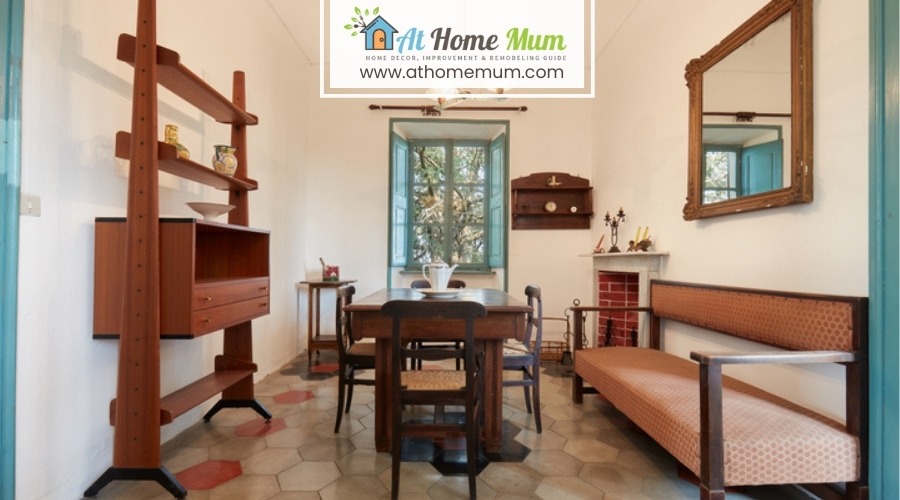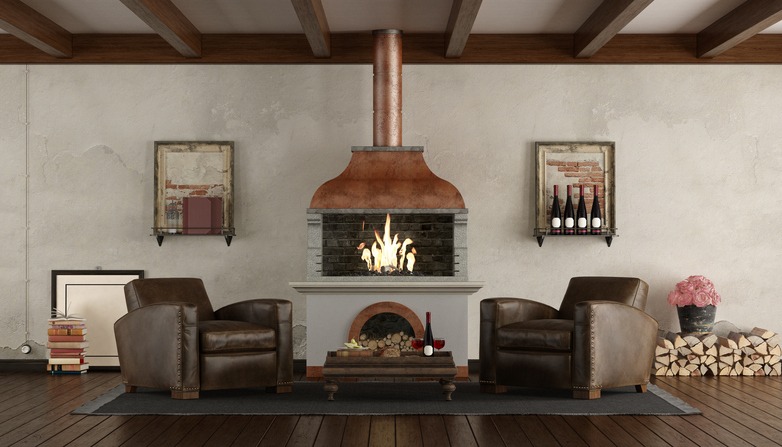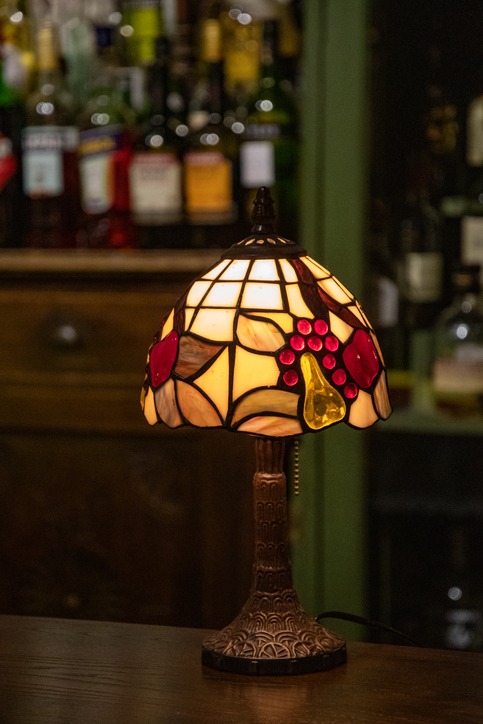Mission Style interior design, rooted in the early 20th century American Arts and Crafts Movement, reflects a profound appreciation for simplicity, durability, and quality craftsmanship. The style originated as a response to the overly ornate Victorian designs of the time, favoring instead a return to utilitarian simplicity and the natural beauty of materials. It draws inspiration from the Spanish missions found throughout California, embodying an aesthetic that embraces earthy color palettes, straight lines, and an exposed structure that showcases the honesty in construction.
In a Mission Style interior, one can expect to see furniture characterized by sturdy construction, often made of oak with a preference for a flat and unadorned appearance that highlights the wood’s natural grain. The design philosophy extends to color choices, which typically involve a range of earth tones such as blues, greens, tans, and yellows, selected to harmonize with the natural world. Accessories and textiles maintain this connection to nature and craftsmanship, with materials such as leather and textiles featuring simple geometric patterns.
The spirit of the Arts and Crafts Movement continues to resonate through Mission Style interiors, where the focus is on creating cohesive spaces that promote a sense of calm and order. The visual emphasis is on structural elements, like exposed joinery, which speaks to the skill and care taken in the creation of the pieces within the space. This style has endured over the years, maintaining popularity for its timeless appeal and the serene and grounded atmosphere it creates in homes.
Historical Context and Origins
Mission Style interior design originated in a confluence of cultural influences and design philosophies, becoming emblematic of a broader movement against industrial mass production at the turn of the 20th century.
California and the Spanish Missions
The aesthetic of Mission Style is directly influenced by the architecture and décor of 18th-century Spanish missions found in California. These missions showcased simple and sturdy structures with clean lines and minimal ornamentation, setting a precedent for the utilitarian yet visually appealing elements of Mission Style.
Arts and Crafts Movement
Mission Style is also a product of the Arts and Crafts movement, which began in the late Victorian Era and took a strong stance against the cheap, mass-produced goods of the Industrial Revolution. This movement cherished handcrafted work, showcasing the beauty of raw materials and traditional craftsmanship, values that Mission Style embodies.
- Key values: Handcrafting, quality, nature-inspired designs
- Opposition: Industrial manufacturing, impersonal designs
Influential Figures
Several individuals left their mark on the development of Mission Style interior design, notably:
- Gustav Stickley: A furniture maker often credited with popularizing Mission Style with his simple, well-made pieces.
- Frank Lloyd Wright: An architect whose work interplayed with the tenets of Mission Style, pushing the boundaries of design in the Craftsman homes he developed.
They infused the style with a philosophy of utility and harmony with the environment, offering an alternative to the more ornate furnishings of the time.
Defining Characteristics of Mission Style
Mission Style interior design emphasizes utility and straightforwardness, focusing on simple lines and quality materials. It is a design philosophy rooted in the Arts and Crafts movement, showcasing the beauty of handcrafted furniture and natural materials.
Design Elements
Mission Style is easily recognized by its straight lines and lack of unnecessary embellishment. Furniture pieces typically feature horizontal or vertical slats or spindles, creating a structured and geometric aesthetic. The design favors rectangular shapes and right angles, ensuring a clean and organized appearance.
- Horizontal and Vertical Lines: Elements that entail structural beauty.
- Rectangular Shapes: Dominant forms in Mission Style furniture.
Craftsmanship Quality
The craftsmanship in Mission Style design is meticulous and highly valued. Every piece of furniture reflects a high degree of craftsmanship, evident in the detailed joinery and solid construction. Exposed tenon joinery is a hallmark of this style, showcasing both the functional and aesthetic qualities of the furniture.
- Exposed Tenon Joinery: Signature joinery technique.
- Sturdy Construction: Indicates durability and quality.
Materials Used
Typical materials in Mission Style furniture include oak, known for its durability and attractive wood grain. Leather and textiles are commonly used in upholstery, often selected in earth tones that harmonize with the natural wood elements.
- Oak: Primary wood choice for its strength and grain patterns.
- Leather and Textiles: Often in earthy colors, complementing the wood.
(Table of Typical Mission Style Materials)
| Material | Use |
|---|---|
| Oak | Framework and structure of furniture |
| Leather | Seats and detail work |
| Textiles | Cushion covers and accent pieces |
Mission Style Furniture
Mission Style Furniture encapsulates a design ethos that emphasizes simplicity, durability, and functionality. It is distinguished by its clean lines and solid construction.
Iconic Pieces
Chairs and tables are quintessential elements in Mission furniture, with the Morris chair being a notable example. This chair typically features straight lines, a high back, and the option for reclining positions – often with leather upholstery adding comfort and sophistication.
- Tables: Dining and coffee tables maintain a square or rectangular shape, supporting the furniture’s no-nonsense aesthetic.
Construction Details
The construction of Mission Style Furniture showcases a dedication to craftsmanship and quality.
- Joints: Traditional joinery techniques like mortise-and-tenon are common, ensuring the furniture’s stability and longevity.
- Lines: Designers stay true to the style’s hallmarks of straight vertical and horizontal lines without unnecessary ornamentation.
Material Selection
Choice of material is critical in Mission Style Furniture, with a predominant use of hardwoods such as white oak.
- Solid Wood: Emphasis is placed on the solid, often quartersawn white oak for its durability and attractive grain that defines the Craftsman aesthetic.
- Leather Upholstery: Top-quality leather is a favored material for upholstered pieces, offering both comfort and durability.
Color Palette and Textiles
Mission-style interior design is anchored in a color scheme of earth tones and warm colors, and it utilizes textiles that complement the simplicity of the furniture and the warmth of the dominant colors.
Dominant Colors
The Mission Style’s color palette is characterized by earth tones, which create a warm and inviting atmosphere. One often sees various shades of tan serving as a backdrop, complementing dark woods typically found in Mission furniture. Other warm colors are utilized to enrich the space without overpowering it.
- Earth Tones:
- Forest green
- Russet
- Sienna
- Warm Colors (used sparingly):
- Burnt orange
- Burgundy
Fabric Choices
When it comes to textiles, Mission Style’s approach is about simplicity and function. Woven textiles are commonly used, both for their texture and durability. They often come in solid colors to maintain the clean lines and uncluttered look of the space.
- Textiles in Use:
- Rugs: Hand-woven and in solid colors to stay true to the style.
- Upholstery: Typically solid, occasionally featuring subtle patterns that reflect nature.
Accentuating Details and Decor
Mission Style interior design focuses on simple lines and handcrafted elements. Highlighting the right accents, particularly through stained glass and diverse lighting options, as well as carefully selected decorative pieces, is crucial for achieving an authentic Mission Style ambiance.
Stained Glass and Lighting
Stained Glass: A characteristic feature of Mission Style, stained glass adds color and artisanal detail to windows and light fixtures. It typically features geometric patterns and nature-inspired motifs.
- Windows: Stained glass windows serve dual purposes—providing privacy and acting as artwork that captures the simplicity and beauty of the style.
- Lighting: Light fixtures with stained glass panels are commonly used, juxtaposing the warm glow of the lamp with vibrant hues from the glass.
Lighting: Strategic lighting accentuates the room’s natural materials and handmade quality. Look for light fixtures made from materials like iron, bronze or wood, and choose lamps with mica lampshades that emit a soft, ambient glow.
- Ceiling Fixtures: Wooden beams often incorporate recessed lighting or iron fixtures to illuminate the room without overpowering it.
- Table & Floor Lamps: Lamps with simple lines and materials complementary to the Mission Style add both function and form.
Decorative Accents
Pillows and Throws: These soft furnishings add comfort to the Mission Style’s often sturdy wooden furniture. Opt for natural fabrics like cotton, wool, or leather in earthy tones.
- Pillows: Use pillows as an understated nod to Mission Style’s Native American influences with subtle patterns.
- Throws: A handwoven throw placed over a chair can introduce texture and warmth to a space.
Mission-Style Decor: Every accent piece should serve a purpose, avoiding unnecessary clutter. Handcrafted pottery, hammered metalwork, and rustic baskets reflect the style’s emphasis on craftsmanship.
- Wall Accents: Tasteful pieces such as wrought iron wall sconces or wooden carvings echo the architecture of Mission Style homes.
- Tabletop Decor: Simple, handmade decorative items like earthenware vases or mission clocks reinforce the design’s dedication to functional beauty.
Incorporating Mission Style in Modern Spaces
In modern spaces, integrating Mission Style combines the appeal of classic craftsmanship with the sleekness of contemporary design. This union emphasizes natural materials and a harmonious color palette to create inviting and cohesive interiors.
Blending Traditions
To blend Mission Style with modern design, one should start with the color scheme. Earthy tones such as blues, greens, tans, and yellows lay a solid foundation for this aesthetic. They provide the right backdrop for showcasing the rich, natural grain of Mission-style furnishings. Clean lines are essential in both Mission Style and modern design – they create a sense of order and space. By selecting pieces with strong, straight lines, designers can harmonize these two styles effectively. Incorporating textiles like rugs and throws with geometric patterns can add warmth and texture, further bridging the gap between old and new.
- Furnishings: Choose items that reveal the beauty of their construction, with an emphasis on horizontal and vertical lines.
- Materials: Look for natural woods with evident grain patterns, and pair them with metals or glass for a modern twist.
- Accessories: Select simple, handcrafted decor to maintain the focus on quality and functionality.
Contemporary Adaptations
Mission Style can be adapted to contemporary settings by focusing on contrast and minimalism. The starkness of modern design often plays well against the warmth and richness of Mission-style elements. For example, placing a Mission oak table amidst sleek, white chairs can create a focal point that draws the eye and invites engagement. Lighting plays a crucial role in setting the tone – choose fixtures that echo the Mission aesthetic with their structured shapes and mellow glow, but ensure they have a modern edge to keep the space feeling up-to-date.
- Lighting: Opt for fixtures with clean geometries and materials like brushed nickel or frosted glass.
- Spatial Layout: Arrange furniture to maximize open space, delineating functional areas while maintaining a sense of flow.
- Textures and Fabrics: Integrate soft furnishings in natural fabrics to balance the clean lines of modern and Mission furniture, adding both comfort and visual interest.
Maintaining and Caring for Mission Furniture
Mission style furniture, known for its quality and durable construction, primarily features solid wood design, which demands specific care to maintain the integrity and beauty of its surfaces.
Regular Upkeep
Daily Care: For routine maintenance, it is recommended to dust Mission furniture regularly with a soft, dry cloth. Avoid using harsh chemicals or abrasive cleaners, as they can damage the wood’s finish.
- Weekly Cleaning: Once a week, use a slightly damp cloth to wipe the surfaces, followed by a dry cloth to avoid moisture buildup.
- Sunlight and Heat: Protecting the furniture from prolonged exposure to direct sunlight and heat sources can prevent the wood from fading or cracking.
Restoration Tips
Scratches and Nicks: Minor scratches can be addressed with color-matching wood markers or shoe polish to blend them into the existing finish. For deeper scratches, seeking a professional’s help may be necessary to avoid further damage.
- Finishing Touches: When the finish looks dull or worn, applying a coat of high-quality furniture wax can help restore its original luster. Allow the wax to sit for a few minutes before buffing with a clean cloth.
- Humidity Levels: Maintaining the room’s humidity levels between 40-45% will help keep the wood from drying out or warping. Use a humidifier in dry climates or a dehumidifier in damp areas to achieve this balance.
Conclusion
Mission Style interior design offers a classic aesthetic that emphasizes robust handiwork and a dedication to craftsmanship. This architectural style stands out for its straightforward and functional approach to interior spaces. Furniture pieces typically showcase a sturdy construction with straight lines, often made from oak, and are characterized by their durability.
Interior designers who favor the Mission Style are drawn to its timeless appeal and the way it marries traditional values with practical design. The key to achieving an authentic Mission Style interior is to focus on the harmony between the various elements within the space. This includes the use of earthy color palettes and natural materials that reflect the surrounding environment, enhancing the sense of cohesion and tranquility.
Incorporating Mission Style into a home’s interior requires careful consideration of both aesthetic and functional elements. Designers should aim to create balance and simplicity, using accessories sparingly but purposefully to accent the strong lines and quality craftsmanship inherent to the style. Ultimately, Mission Style interior design is about creating spaces that are both beautiful and livable, reflecting an appreciation for artisanal quality and classic design.





